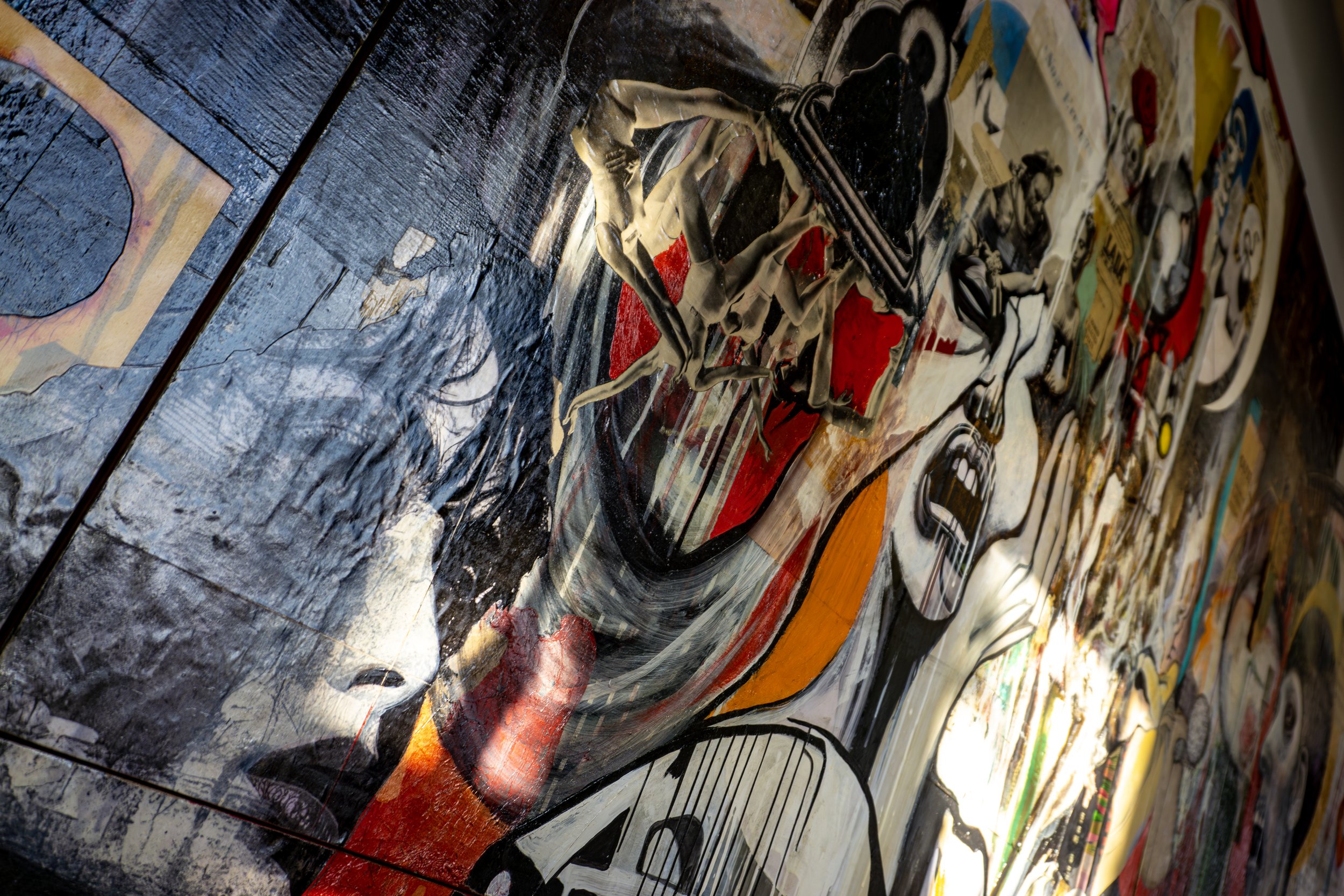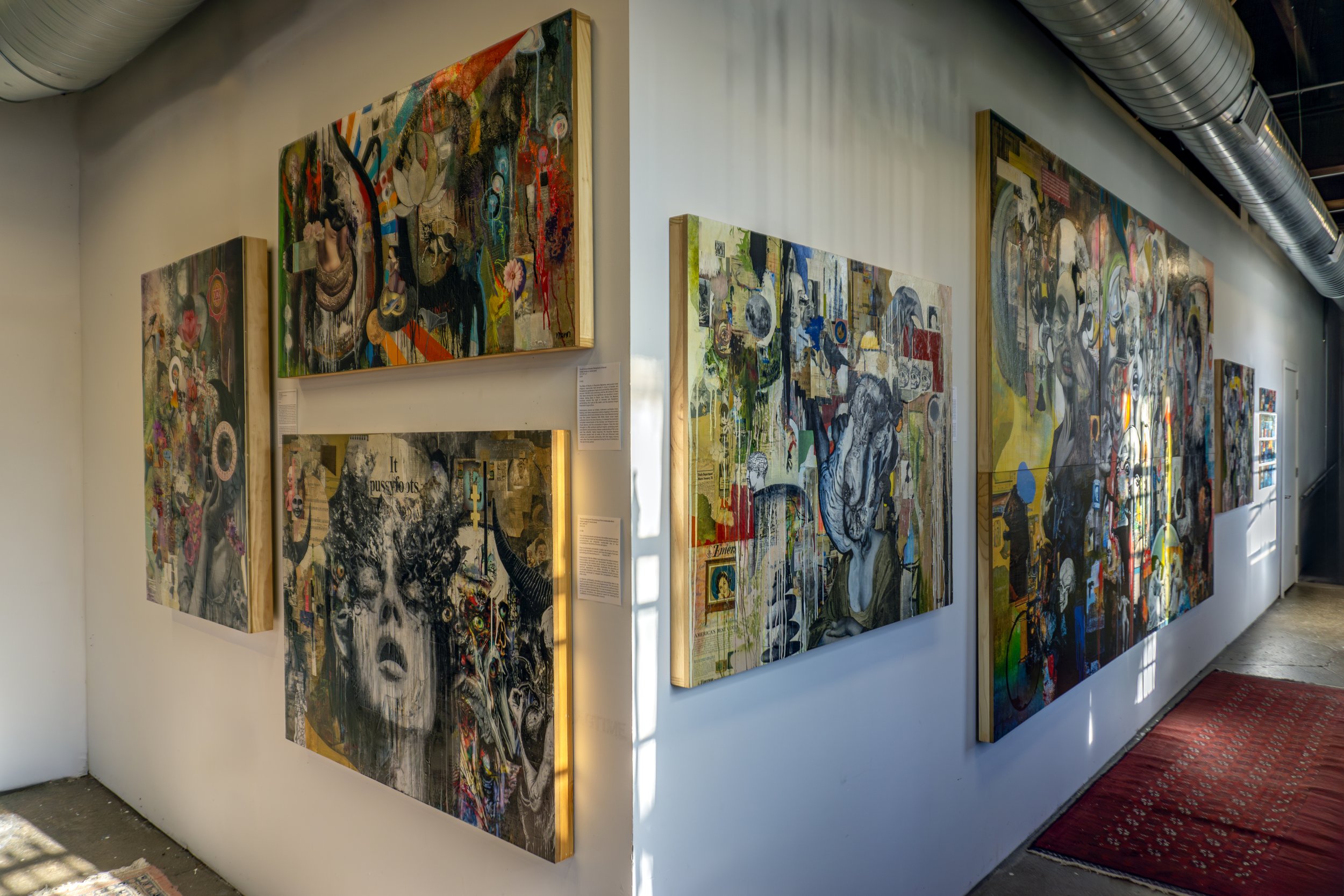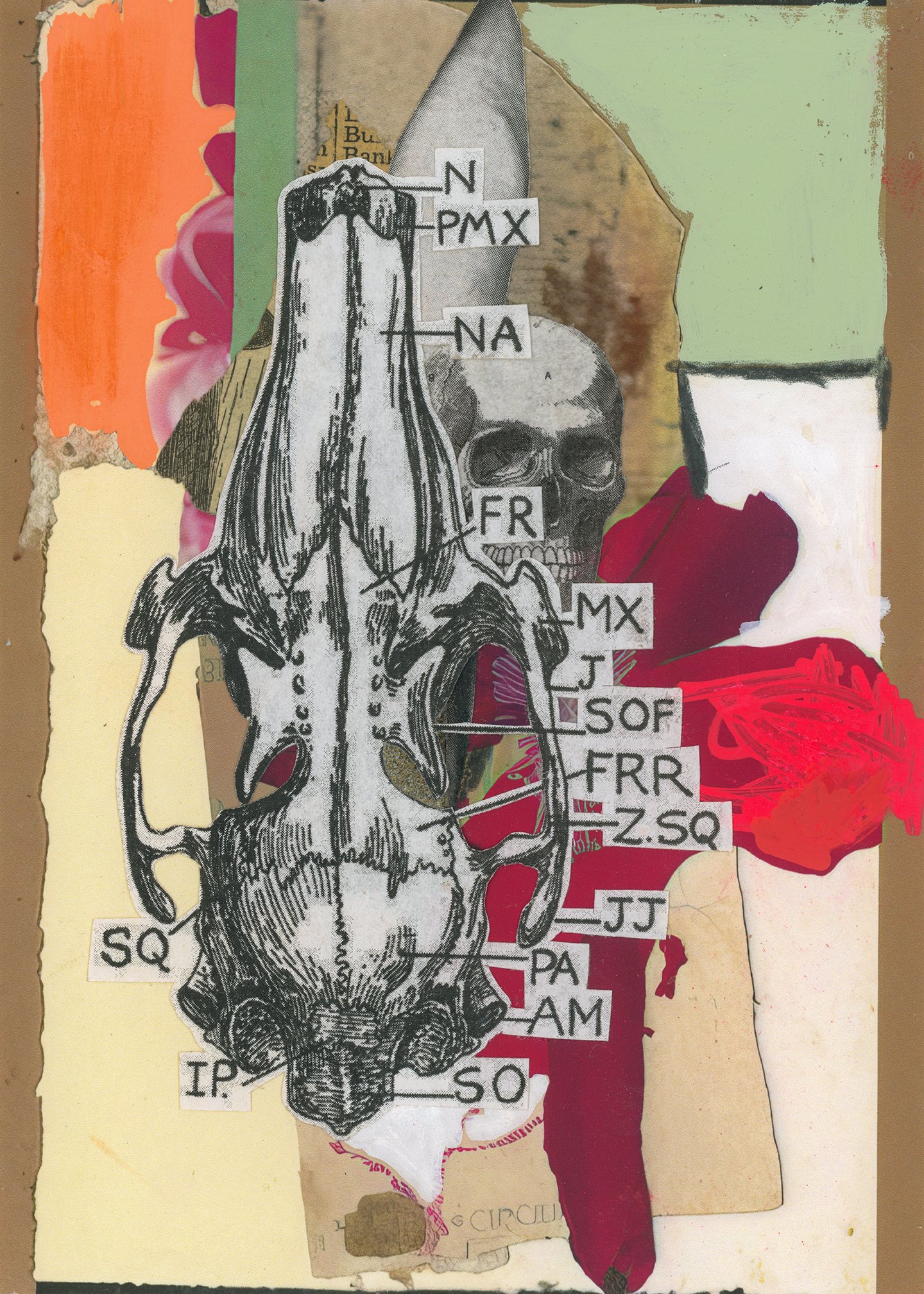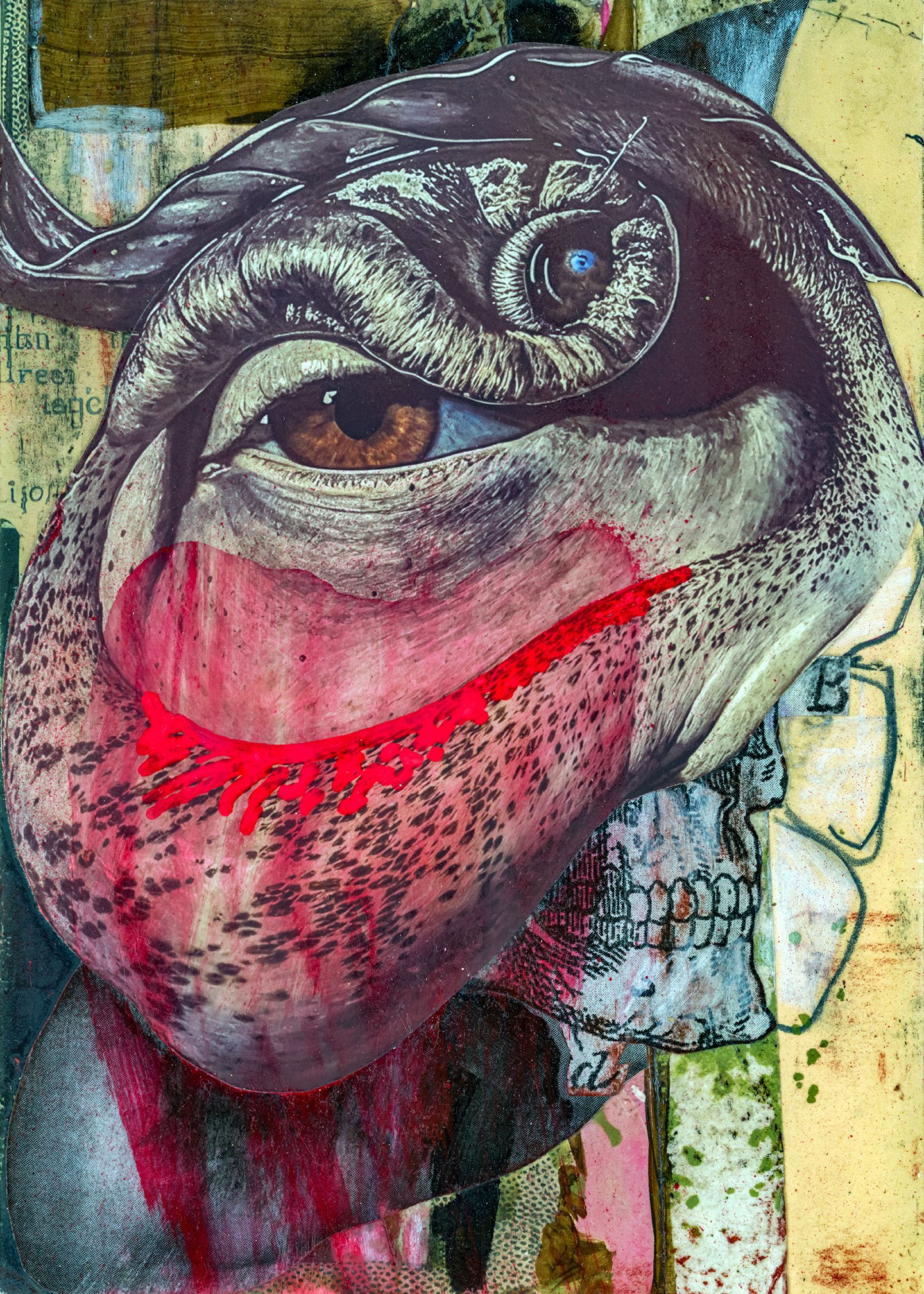A Solo Exhibition
theartofmann
September 13, 2024
6-9pm
Secret Studio
Columbus, Ohio
Special musical performances by
Sarah Asher
TH13TEEN showcases 13 new works that delve into the intersections between free will and predeterminism, presence and dreaming. The exhibition includes a series of paintings and a spoken word collage film, marking theartofmann's first showcase of new paintings in four years. This hiatus has been a period of intense exploration for the artist, involving the creation of digital paintings, the discovery of new techniques, and harnessing the randomness of AI-generated images.
The works presented in TH13TEEN were crafted over the past two years, with some pieces originating as far back as the early 2000s. As theartofmann explains, "There are two pieces in this series that I began painting in 2002 and 2007 that I could not finish until now—they were waiting for the technology and my skills to catch up with the vision.
theartofmann’s process is as intriguing as the works themselves. The mixed media pieces on wood panels incorporate acrylic, latex and spray paint, alongside a variety of unconventional materials like stains, glazes, dirt, and ash. "I use everything. I trust my intuition and work without a focused outcome—the painting, the meaning, materializes through the process—gives birth to itself," says the artist. The blending of physical painting, digital painting, and AI image manipulation is central to TH13TEEN. Physical works are photographed and integrated into digital formats, altered then printed, cut up, and collaged back into the canvas. AI is employed to analyze the concepts and aesthetics of certain images and combine them to create a single, cohesive new novel image.
“Millions of images, that’s what I eat”









The Prophets of Strange Religions
“When the prophets of strange religions ball out their bizarre despair do not join them on the mountain say only it is here it is here. Break your bones to mend your soul, die trying, a constellation of unabsolved fury a dichotomy of distress. Born of rage. Forced into narrower and narrower avenues of existence not by other but by self, is this who I really am?”
"The Prophets of Strange Religions" is a short film that emerges from a journey of introspection and philosophical exploration, initially beginning as a blog post on theartofmann.com titled "SOME MEN JUST WANT TO WATCH THE WORLD BURN," dated September 17, 2019. The post captures a vivid scene of dissent, advising against joining the despairing cries of "prophets of strange religions" and instead embracing the reality of the here and now. This seed of thought expanded as I recorded myself reading "The Prophets" along with other writings on December 4, 2023, creating an audio piece that deeply resonates with the themes of Friedrich Nietzsche’s "Thus Spoke Zarathustra."
Over the following month, these recordings transformed into a 33-minute audio piece comprising 15 tracks, which continued to evolve in my mind. By March 2023, driven by the persistent impact of the audio explorations, I decided to adapt the work into a film. I began collecting public domain footage from various sources, aiming to visually represent the existential and philosophical inquiries sparked by the initial blog post.
The film, while rooted in the exploration of self-realization and the rejection of conventional norms, focuses less on portraying a linear narrative and more on invoking a meditative reflection on Nietzsche's ideas. It challenges viewers to confront personal hardships and societal pressures, advocating for a life lived with authentic presence and relentless pursuit of personal truth. The film concludes by urging viewers to reject passive acceptance of societal roles, emphasizing personal responsibility and the pursuit of self-realization, encapsulating Nietzsche’s critique of conventional morality and the imperative to forge one’s path.
All Suppressed Truths Become Poisonous (Fear of the Devil)
mixed media on wood panel
38 ½” x 49” x 2”
2023-24
Friedrich Nietzsche asserted that "Silence is worse; all truths that are kept silent become poisonous," emphasizing the profound dangers of repression and the vital importance of confronting reality. He argued that when uncomfortable truths are ignored or denied, they do not disappear; instead, they intensify and mutate into something far more destructive, gradually eroding both the individual’s psyche and the fabric of society. This concept is central to his critique of modern morality, which he perceived as hypocritical and deeply rooted in denial. Nietzsche particularly criticized the repression of natural instincts and the "will to power," the fundamental driving force behind human creativity and ambition, which he believed leads to widespread resentment and a pervasive lack of authenticity in both personal and cultural life.
Nietzsche emphasized the necessity of confronting the darker aspects of existence—such as suffering, chaos, and death—rather than retreating into comforting illusions that provide a false sense of security. He argued that a truly healthy culture must maintain a delicate balance between the Apollonian elements of order, reason, and harmony, and the Dionysian forces of chaos, passion, and the irrational. When the truths associated with these darker, Dionysian aspects of life are suppressed, they become toxic, leading to a dangerous disconnection from reality and ultimately causing societal decay.
Bakhmut
mixed media on wood panel
48” x 72” x 2”
2023-24
The Battle of Bakhmut, a significant episode in the ongoing conflict in Eastern Ukraine, primarily unfolded in and around the city of Bakhmut in the Donetsk Oblast. Starting in early 2022, amidst the broader Russian invasion of Ukraine, Bakhmut became a focal point due to its strategic location and infrastructure. Initial skirmishes and artillery exchanges in early 2022 escalated into a full-scale battle by late 2022 and early 2023, as Russian forces, including regular army units and Wagner Group mercenaries, launched intensified assaults on the city. Ukrainian forces fortified Bakhmut, leading to protracted and bloody urban warfare. The city endured heavy shelling, resulting in significant civilian casualties and infrastructure damage, while ground assaults involved intense street fighting. Despite being outnumbered and facing severe supply shortages, Ukrainian defenders managed to hold key parts of the city for an extended period. By mid-2023, the battle had largely reached a stalemate, with neither side achieving a decisive victory. Casualty estimates vary, but reports suggest that both sides suffered tens of thousands of military casualties, with civilian casualties also in the thousands due to the heavy fighting and shelling. The prolonged conflict in Bakhmut not only drained resources and morale from both sides but also led to a severe humanitarian crisis, with many civilians trapped without access to necessities. The battle had a profound impact on the city's civilian population, with many displaced, injured, or killed.
Chang'e (I Want To & I Can't Believe)
mixed media on wood panel
34 ½” x 64” x2”
2007-24
Chang'e's story is intricately woven with themes of love and sacrifice, culminating in her dramatic ascent to the moon. She was married to Hou Yi, a heroic archer who, by shooting down nine of the ten suns, saved the Earth from scorching heat. Recognized for his bravery, Hou Yi was gifted an elixir of immortality by the gods. Despite the incredible power it offered, Hou Yi was reluctant to use it, as he did not wish to part from Chang'e and live forever without her.
As the legend goes, word of the elixir's existence spread, and it wasn't long before others coveted its power. One day, while Hou Yi was away, a greedy apprentice broke into their home to steal the elixir. In a desperate moment to protect the elixir from falling into the wrong hands and perhaps also tempted by the prospect of immortal life, Chang'e swallowed it herself. The elixir's potent magic worked instantaneously, causing her to ascend towards the heavens, far beyond the reach of any mortal, including her beloved Hou Yi.
Destined to live forever, Chang'e found her new abode on the moon, where she became its immortal goddess. Accompanied by the Jade Rabbit, who crafts the elixir of immortality, she watches over the world she left behind, forever separated from her husband but eternally remembered for her sacrifice.
Misanthropical Dream #13 (The Impossibility of the Existence of Anything)
mixed media on wood panel
49” x 37” x 2”
2024
Do you see him?
Do you see the story?
Do you see anything?
It seems to me I am trying to tell you a dream—making a vain attempt, because no relation of a dream can convey the dream-sensation, that commingling of absurdity, surprise, and bewilderment in a tremor of struggling revolt, that notion of being captured by the incredible which is of the very essence of dreams… No, it is impossible; it is impossible to convey the life-sensation of any given epoch of one’s existence—that which makes its truth, its meaning—its subtle and penetrating essence. It is impossible. We live, as we dream—alone…
He paused again as if reflecting, then added: "Of course in this you fellows see more than I could then. You see me, whom you know..." It had become so pitch dark that we listeners could hardly see one another. For a long time already he, sitting apart, had been no more to us than a voice. There was not a word from anybody. The others might have been asleep, but I was awake. I listened, I listened on the watch for the sentence, for the word, that would give me the clue to the faint uneasiness inspired by this narrative that seemed to shape itself without human lips in the heavy night-air of the river.
Oculi Omnes Videntes (Hierophant of Eleusis)
mixed media on wood panel
27” x 51” x 2”
2024
The Rites of Eleusis, or Eleusinian Mysteries, were ancient Greek religious ceremonies held annually in honor of Demeter and Persephone, goddesses of agriculture and fertility. Dating back to around 1500 BCE and continuing until the 4th century CE, these rites were among the most significant and secretive in ancient Greece, taking place in Eleusis, near Athens. The Mysteries revolved around the myth of Demeter and Persephone, symbolizing the cycle of life, death, and the seasonal changes essential to agriculture.
Participants, known as initiates, underwent purification rituals, fasting, and other preparations before engaging in the secretive ceremonies, which were divided into the Lesser Mysteries (spring) and the Greater Mysteries (fall). While details remain largely unknown due to the vow of secrecy, it is believed the ceremonies included reenactments of the Demeter and Persephone myth, ritual dances, and the consumption of kykeon. These rites were thought to offer profound spiritual insights, symbolizing death and rebirth, and promising a deeper understanding of life's cycles and the afterlife. Highly respected, the Eleusinian Mysteries attracted people from all walks of life and influenced Greek culture and spirituality profoundly, with their legacy enduring even after they were suppressed during the rise of Christianity in the late Roman period.
SIA (Here Are Great Thoughts Seared Alive and Boiled Small)
mixed media on wood panel
36” x 72” x 3”
2024
The human condition is marked by a profound existential struggle between our lofty aspirations and the harsh, indifferent realities of life. As we seek meaning and understanding, we often find our grand ideas and ideals subjected to a violent, painful process of reduction. What begins as expansive, profound thoughts are frequently diminished, simplified, or even destroyed by the brute forces of reality. Society, with its conformist tendencies, often trivializes these ideals, reducing them to mere platitudes or moralistic dogma, stripping them of their original depth and significance.
This clash between human consciousness—capable of conceiving great, abstract thoughts—and the indifferent or hostile nature of the universe highlights the inherent absurdity of existence. Life, in its essence, is a confrontation with this absurdity, where the quest for meaning is met with resistance, suffering, and the inevitable disillusionment that follows. Despite the nobility of our thoughts and the grandeur of our ideals, they are vulnerable to being diminished or erased by the uncaring forces of the world. In the end, our efforts to find or create meaning are ultimately futile, as even the most profound ideas are ephemeral and insignificant within the vast, indifferent cosmos. This realization underscores the anxiety that haunts human endeavors, as we come to terms with the void—a universe that offers no inherent meaning or purpose, leaving us to grapple with the fleeting nature of our aspirations and the reduction of our complex ideas into oversimplified forms.
The Ascending and Descending of the Unattainable Mind
mixed media on wood panel
36” x 48” x 2”
2023-24
The continuous ascent and descent, the endless quest for an ideal or truth that can never be fully realized and that certain aspects of consciousness are inherently unattainable due to their complexity or the limits of human perception.
Then he dreamed, and behold, a ladder was set up on the earth, and its top reached to heaven; and there the angels of God were ascending and descending on it.
Genesis 28:12
Philosophers like Ken Wilber have explored this balance between transcenders (ascenders) and descenders. Ascenders focus on transcending the material world, striving for elevated states of awareness, whereas descenders emphasize the grounding of spiritual experiences in reality. According to Wilber, true nonduality requires a harmonious integration of both processes, allowing individuals to navigate the complexities of existence effectively.
In Platonic philosophy, ascending and descending relate to the soul's journey toward truth and enlightenment. The soul ascends to grasp higher truths but may also descend into confusion due to distractions and ethical failings. This dual movement is part of the mind's oscillation between higher aspirations and the recognition of human limitations, the perpetual search for meaning in an indifferent or incomprehensible universe.
The Body of KAALAPURUSHA (Time Personified [The Persistence of Memory])
mixed media on wood panel
48” x 36” x 3”
2019-24
Kaalapurusha, meaning "Personification of Time," is a significant concept in Hindu mythology, symbolizing the embodiment of time and the universe. This cosmic being represents the entire span of temporal existence, with each part of his body symbolizing different aspects of the cosmos. Closely tied to the cyclical nature of creation, preservation, and destruction, Kaalapurusha is associated with the Yugas and Kalpas, the cosmic cycles that govern the universe. He is often linked with Lord Shiva in his form as Mahakala, the Great Time, who embodies the destructive aspect of time necessary for transformation and renewal. This association underscores the cyclical process of creation and destruction, essential for the continuity of existence.
In various Hindu scriptures such as the Puranas, Vishnu Purana, and Bhagavata Purana, Kaalapurusha is depicted as a vast cosmic being encompassing the universe. The Bhagavad Gita presents a similar vision through Lord Krishna's cosmic form, illustrating the all-encompassing nature of time. Kaalapurusha serves as a profound symbol of the temporal nature of existence and the cosmic order, encouraging an understanding of life's impermanence and promoting spiritual growth and detachment. This concept highlights the transient and ever-changing material world, contrasted with the eternal, timeless spiritual reality, reflecting the dual understanding of time in Hindu cosmology.
The Moirai (The Three Fates [The Spinner, The Allotter & The Unturnable])
mixed media on wood panel
84” x 143” x 2”
2002-24
The Moirai, or Fates, are deeply entrenched in Greek mythology as symbols of unchangeable destiny. Often portrayed as ancient and powerful deities, they are sometimes considered older than the Olympian gods. Their origins vary: in Hesiod's "Theogony," they are daughters of Zeus and Themis, emphasizing their role in maintaining natural order and justice. Themis personifies divine law, highlighting the Fates' role in ensuring a predetermined cosmic path. In other accounts, they are daughters of Nyx (Night), representing their primordial and inevitable nature. Nyx, a primordial deity, underscores the Moirai's ancient and inexorable characteristics and their connection to the universe's mysterious and inescapable aspects.
Clotho’s (The Spinner) role is to spin the thread of life. Her act of spinning represents the birth and the initial circumstances of an individual's life.
Lachesis (The Allotter) measures the thread of life, deciding the length of each life and its destiny. She allots to each person their fate, distributing the experiences and events they will encounter.
Atropos (The Unturnable) cuts the thread of life. She is the one who decides the manner and time of each person's death, ensuring that the destiny meted out by the Moirai is fulfilled.
The Mourning of the Unceasing Relinquishing of Each Moment to the AEther
mixed media on wood panel
40 ¾” x 49” x 2”
2023-24
The concept of presence—of being so deeply aware, so fully immersed in each moment, so attuned to the essence of existence—can give rise to an intense mourning for the passing of each fleeting instant as it fades into the AEther. This overwhelming compassion for the passage of time, the open raw heart, the inevitable loss.
Heraclitus famously stated that "everything flows," that constant change and impermanence defines the universe, Laozi describes the Tao as "the source of all things," an ever-present yet intangible force that underlies all existence. In “De Rerum Natura”, Lucretius presents a vision of the world as "nothing exists except atoms and empty space; everything else is opinion," depicting a universe in perpetual flux where moments are fleeting, and life is merely a temporary arrangement of atoms. T.S. Eliot, in “The Waste Land”, poignantly reflects on the fragmentation and impermanence of contemporary life, writing, "These fragments I have shored against my ruins". Søren Kierkegaard, wrote in “Fear and Trembling”, "It is man's lot to be reduced to nothing," and Friedrich Nietzsche, observed that "time is a thief of youth."
The unceasing relinquishing of each moment to the AEther, the continuous flow into the ungraspable expanse, the fading away into the infinite. The mourning replacing the moment.
This Thing Between Us (The Serpent Dream)
mixed media on wood panel
24” x 32” x 2”
2024
Throughout history, the serpent and woman together have symbolized a complex interplay of wisdom, power, and transformation. The serpent embodies the dualities of wisdom and deceit, life and death, while the woman represents the feminine psyche, intuition, fertility and the subconscious mind. In various cultures, this pairing has been linked to the divine feminine, as seen in ancient Greek mythology with Athena, and the Minoan Snake Goddess of Crete. The Biblical story of Eve and the serpent further intensifies this imagery, associating it with themes of temptation, knowledge, and the fall from innocence.
Psychologically, the appearance of a woman and serpent together in a dream is often interpreted as a reflection of inner conflicts or profound transformations. Carl Jung, the Swiss psychologist, viewed the serpent as a symbol of the unconscious and primal instincts, while the woman frequently represented the anima, or the soul. When these two archetypal figures appear together in dreams, they may signify an ongoing reconciliation or confrontation between different aspects of the self. This imagery suggests the dreamer’s struggle to integrate repressed or feared elements of their psyche, highlighting the dynamic tension between the conscious and unconscious mind. The woman’s interaction with the serpent can represent an individual's attempt to harness or come to terms with these powerful, often conflicting forces within their inner world.





























![The Body of KAALAPURUSHA (Time Personified [The Persistence of Memory]) NFT Title Card from TH13TEEN on Manifold XYZ and Foundation App $TH13 token, all linked to the TH13TEEN exhibition.](https://images.squarespace-cdn.com/content/v1/63a0e1c869c11b4cdc39c42b/5baf4895-4f49-4ad5-a7d5-6ede647c9a49/The+Body+of+KAALAPURUSHA+%28Time+Personified+%5BThe+Persistence+of+Memory%5D%29+NFT)
![The Moirai (The Three Fates [The Spinner, The Allotter & The Unturnable]) NFT Title Card from TH13TEEN on Manifold XYZ and Foundation App $TH13 token, all linked to the TH13TEEN exhibition.](https://images.squarespace-cdn.com/content/v1/63a0e1c869c11b4cdc39c42b/b1ccd31a-b69b-4dfc-8299-7697c313a26a/The+Moirai+%28The+Three+Fates+%5BThe+Spinner%2C+The+Allotter+%26+The+Unturnable%5D%29+NFT)











































































































